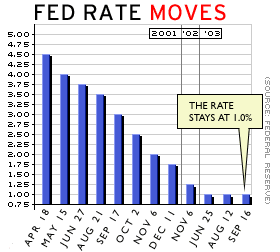NEW YORK (CNN/Money) -
When Federal Reserve policy-makers announced this week that they were leaving short-term interest rates at 40-year lows, they also said the labor market was weakening and that inflation could be in for a fall.
Some economists thought that was a bunch of malarkey.
"The Fed wants everyone to know that rates are going nowhere and will not let facts get in the way," said Joel Naroff, president and chief economist at Naroff Economic Advisors in Holland, Pa.

According to some analysts, the Fed has been once bitten by its inability to communicate with the bond market, and now it's twice shy about sparking the kind of bond selloff that followed its June policy decision.
In May and early June, bond traders got the impression the Fed planned to cut its target for its key interest rate by an aggressive half-percentage point and that its next move might be to buy longer-term Treasury bonds.
In expectation of super-low rates and super-high prices for bonds -- rates and prices move in opposite directions -- traders rushed into the market and sank the rate on the 10-year Treasury note to its lowest level in 45 years.
Alas, the Fed cut only a quarter of a percentage point from rates in June, and Fed Chairman Alan Greenspan made it clear the Fed had little appetite for long-term Treasury bonds. The result was a swift reversal in rates, as bond traders rushed back out of the market.
Fed officials have talked ever since about the need for better communication, and Tuesday's Fed statement -- which was much gloomier about the economy than many economists have been lately -- seemed to some an indication the Fed was willing to stretch the truth to keep traders buying bonds.
| Related stories
|

|
|
|
|
"Clearly, the Fed's cautious view on substantially low inflation is a device geared at preventing a further runup in yields, rather than a reflection of the central bank's cautiousness with price deceleration," said Ashraf Laidi, chief currency analyst at MG Financial Group in New York.
Even if the Fed really does believe the labor market and inflation outlook are weakening, completely ignoring the recent signs of economic strength is still misleading, according to Anthony Crescenzi, bond analyst at Miller Tabak & Co.
"They could have said there's a clear acceleration in economic activity currently under way, but it remains at risk of weakening or reversing, owing to the labor market and other factors," Crescenzi suggested. "To leave it out completely doesn't make any sense to me -- it's as if they think the market's full of dummies."
The risk is that, if it stays too gloomy for too long, the Fed could lose some of the credibility it needs to manipulate the bond market and interest rates.
"They have a lot of good will built up; it would take repeated actions like this for the Fed to lose credibility," Crescenzi said. "But if they continue to talk pessimistically while the numbers call for a more optimistic outlook, there will [begin to be a disconnect] between where the Fed would like to see interest rates and where investors believe rates should be."
Not just whistling Dixie
But right now, the Fed's got numbers to back up its stated theory that the economy has so much "slack," in unused workers and production capacity, that it will have to grow for a long time before prices budge and jobs get created.
For example, despite a big pickup in economic growth late this summer, the Labor Department said this week that, excluding volatile food and energy prices, its consumer price index (CPI) rose just 1.3 percent in the 12 months ended in August. That was the slowest growth rate since 1986.
"Inflation decelerated across a broad spectrum of core CPI areas -- about 40 percent of prices in the core showed declines in their year-over-year growth rate. That's a big proportion," said Robert Brusca, chief economist at Native American Securities in New York. "The Fed is concerned and has a reason to be concerned."
As for the labor market, there have been hopeful signs that the level of layoffs has slowed down, but there have been no signs yet that jobs are being created.
Though unemployment fell in August to 6.1 percent, businesses also cut 93,000 more jobs, and some of the recent decline in unemployment can be attributed to the fact that about 566,000 people have given up looking for work in the past two months, removing themselves from the unemployment arithmetic.
Meanwhile, the number of new weekly claims for unemployment benefits has hovered stubbornly around 400,000, the standard benchmark for labor-market weakness. Though manufacturing surveys show stronger production, they also show continued layoffs.
Though businesses have hired 94,000 temporary workers since April -- usually a leading indicator of future job growth -- the pace of that hiring slowed in August, and the number of hours worked per week, another leading indicator, remains stagnant.
"The Fed is being very serious when it says this labor market remains exceptionally weak -- in fact, it's the weakest [since World War II], by many measures," said former Fed economist Wayne Ayers, now chief economist with Fleet Boston Financial. "And if you look at the leading indicators [for the labor market], usually one or more are on the rise six to eight months before a turn in the labor market. Right now, none are on the rise."

|

